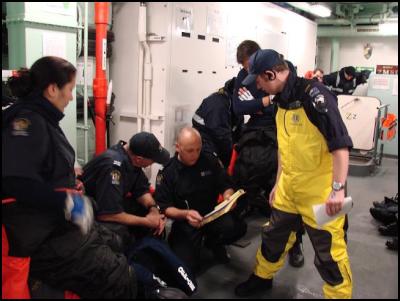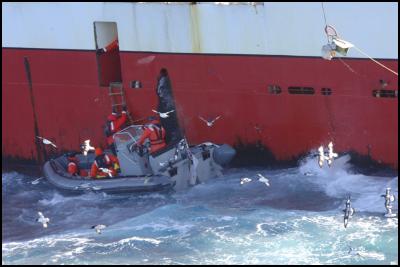Successful Operation for Navy and Fisheries
Successful Operation for Navy and Fisheries

Click to enlarge
Shows Boarding Party briefing onboard a fishing vessel – from left Fishery Investigator Gary Wright, Fishery Officer’s Tamara Fitzgerald, John Kennedy and Jason Corbett with Navy Sub Lieutenant Patrick Baker. Photo: NZDF Official

Click to enlarge
Boarding crew alongside one of the boarded fishing vessels. Photo: NZDF Official
Media Release
Monday, 10
September 2007
SUCCESSFUL OPERATION FOR NAVY AND FISHERIES
Navy Frigate, HMNZS TE MANA sailed from Devonport in late August in support of the Ministry of Fisheries, and in particular, the enforcement of fish species quotas in the waters around New Zealand.
The joint operation began on Sunday 2 September on completion of a successful port visit to Timaru - the first ever for the frigate. With MFish Officers onboard, TE MANA sailed south to the Campbell Island Plateau in the Southern Ocean tasked to intercept and board vessels catching the Southern Blue Whiting. Briefings were conducted during the voyage south covering meteorology and intelligence as well as drills and discussions to establish the working guidelines for Navy and MFish personnel on the joint operation. Noting the future Naval Patrol Force, under Project Protector, multi-agency operations will become more frequent in and around the NZ EEZ.
Arriving in the operational area, TE MANA utilised the ship’s helicopter as “eyes in the sky” whilst the first boarding took place using the ship’s Boarding Team and MFISH Officers. Noting the air temperature was 1 degree with 3 – 4 metre swells and some snow, this was not an easy task. Once on board the first vessel, the intricacies of a large processing trawler were explained to the Boarding Team whilst the MFISH Officers completed their checks. Dual boardings were completed in the afternoon using two Boarding Teams to inspect two fishing vessels concurrently.
The second day of the operation brought more challenging seas and in these adverse conditions two more boardings were achieved bringing a total of five successful boardings in the first two days. The next task was to move north to the Auckland Islands to board vessels involved in scampi trawling. Arriving in the designated task area, three fishing vessels were boarded; one involved a bumpy seven mile trip up the harbour in deteriorating weather conditions testing the determination and skills of TE MANA’s seaboat crews.
After the successful boarding in the Auckland and Campbell Island Plateau, TE MANA headed towards Dunedin on the lookout for two ling and hake trawlers on the way. Again in adverse conditions, one of the vessels was boarded, with the deteriorating weather conditions preventing boarding of the second. Innovation prevailed and the second vessel was questioned via VHF radio.
After 96 hours and nine successful boardings, TE MANA turned for the shelter of Otago Harbour, leaving behind fisherman plying their trade in one of the most unforgiving environments in the world One of the Navy Boarding Party Officers, Sub Lieutenant Patrick Baker said of the operation, “Going to the Southern Ocean and noting the tasks we were performing, I had thought that we would get a cold welcome to match the weather, however in most cases the people that I met were happy to talk about the differences and similarities we both faced in our jobs. It is in that respect that I will remember this cold week in September, and look forward to future multi-agency operations”.
MFish Manager Maritime Operations Gary Orr said it was a great opportunity to get out and work with the Navy in the Southern Ocean again.
“The ability to work with Navy and the seven new vessels due to arrive in the Project Protector fleet will increase MFish’s ability to inspect fishing vessels and protect the sustainability of New Zealand’s valuable fisheries.”
The fact that MFish can turn up in places like the sub-Antarctic reinforces that with Project Protector, fishing vessels can expect to see us anywhere and at any time.”
HMNZS TE MANA departs Dunedin on Tuesday 11 September headed home to the Devonport Naval Base.
ENDS
Visit www.navy.mil.nz


 Gordon Campbell: On Budget 2025
Gordon Campbell: On Budget 2025 Rainbow Wellington: Rainbow Wellington Concerned By Reports Of Increased Abuse
Rainbow Wellington: Rainbow Wellington Concerned By Reports Of Increased Abuse ACT New Zealand: David Seymour's Budget Day Speech 2025
ACT New Zealand: David Seymour's Budget Day Speech 2025 Government: Minister Of Finance’s Budget 2025 Speech
Government: Minister Of Finance’s Budget 2025 Speech The Prosperity Deal: Govt Budget Has No Plan For AI Job Loss – Citizens Launch The Prosperity Deal As The Only Workable Alternative
The Prosperity Deal: Govt Budget Has No Plan For AI Job Loss – Citizens Launch The Prosperity Deal As The Only Workable Alternative Greenpeace New Zealand: Greenpeace Braced For ‘Scorched Earth’ Budget From Govt
Greenpeace New Zealand: Greenpeace Braced For ‘Scorched Earth’ Budget From Govt NZ Police: Police Acknowledge Sentencing Of Donald Sarratt In Child Sexual Abuse Material Case
NZ Police: Police Acknowledge Sentencing Of Donald Sarratt In Child Sexual Abuse Material Case


